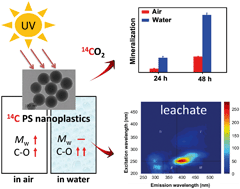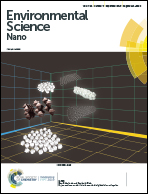A carbon-14 radiotracer-based study on the phototransformation of polystyrene nanoplastics in water versus in air†
Abstract
Nanoplastic (<1 μm plastic debris) pollution, derived from degradation of larger plastic debris or direct release from cosmetic or cleaning products, is an emerging concern in the environment. In this study, we quantitatively investigated the degradation and mineralization of polystyrene (PS) nanoplastics under ultraviolet (UV) radiation at 254 nm using 14C radioisotope tracer technology. 14C-polystyrene (PS) nanoplastics were synthesized from 14C-styrene. Moreover, to study the role of water during the photodegradation of PS nanoplastics, 14C-PS nanoplastics were exposed to UV radiation in air or suspended in water. The X-ray photoelectron spectroscopy (XPS) results showed that after 48 h of UV irradiation, C–O groups formed on the surface while no significant change was observed from the Fourier-transform infrared spectroscopy (FTIR) analysis, indicating that short-term photo-oxidation only occurs on the thin surface layer of the PS nanoplastics. The molecular weight (Mw) of the PS nanoplastics increased in air after the irradiation, suggesting cross-linking of the PS chains, while it did not show significant changes in the presence of water. The mineralization of the PS nanoplastics was higher in water (17.1 ± 0.55%) than in air (6.17 ± 0.1%). A significant amount (11.0 ± 0.1%) of by-products with small Mw was detected in water during UV irradiation, much higher than that being washed out from the surface of nanoplastics exposed in air. The higher photoreactivity in water suggests that the mechanisms underlying the phototransformation of the PS nanoplastics in the two matrices could be different. The present study provided the first evidence of photodegradation of PS nanoplastics in aqueous environments.

- This article is part of the themed collection: Nanomaterials in air


 Please wait while we load your content...
Please wait while we load your content...